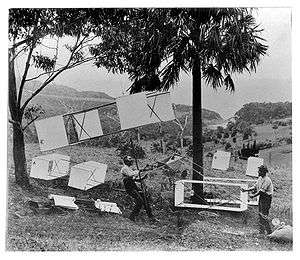Box kite


A box kite is a high performance kite, noted for developing relatively high lift; it is a type within the family of cellular kites. The typical design has four parallel struts. The box is made rigid with diagonal crossed struts. There are two sails, or ribbons, whose width is about a quarter of the length of the box. The ribbons wrap around the ends of the box, leaving the ends and middle of the kite open. In flight, one strut is the bottom, and the bridle is tied between the top and bottom of this strut. The dihedrals of the sails help stability.
The box kite was invented in 1893 by Lawrence Hargrave,[1] an Englishman who emigrated to Australia, as part of his attempt to develop a manned flying machine. Hargrave linked several of his box kites (Hargrave cells) together, creating sufficient lift for him to fly some 16 ft (4.9 m) off the ground.[2] A winged development of this kite is known as the Cody kite following its development by Samuel Franklin Cody. Military uses also involved a kite/radio transmitter combination issued to pilots during World War II for use in liferafts.[3]
Large box kites are constructed as cellular kites. Rather than one box, there are many, each with its own set of sails.
Most of the altitude records for kite flying are held by large box kites, with Dacron sails, flown with Spectra cable. Before Dacron, Spectra, and Kevlar were available, high performance box kites used oiled silk, linen or hemp sails, and were flown with steel cable. Silk, linen and hemp were used because they could be spun finer than cotton and stretched relatively little when wet. Steel had the highest available strength for its weight.
See also
References
- ↑ "The Powerhouse Museum".
- ↑ W. Hudson Shaw; O. Ruhen (1977). Lawrence Hargrave: Explorer, Inventor and Aviation Experimenter. Cassell Australia. OCLC 4466434.
- ↑ Meulstee, Louis; Bloom, G & J (October 2002), "The Gibson Girl transmitter and kite" (PDF), The Kiteflier, The Kite Society of Great Britain (93), pp. 19–23
External links
- Cellular kites at the Virtual Kite Zoo
